Table of content
Stir-fried pork intestines, or “chao da chang” in Mandarin, is a beloved dish in Chinese cuisine renowned for its unique texture and bold flavors. Achieving the perfect crispiness, however, requires precision, patience, and an understanding of the intricate balance between preparation and cooking techniques. This article delves into the secrets of crafting irresistibly crispy stir-fried pork intestines, from selecting the finest ingredients to mastering the final plating. Whether you’re a seasoned home cook or a curious food enthusiast, this guide will equip you with the knowledge to elevate this humble ingredient into a culinary masterpiece.
The Allure of Crispy Pork Intestines
Pork intestines, often overlooked in Western kitchens, hold a revered place in Asian culinary traditions. When prepared correctly, they offer a delightful contrast of textures: a crisp exterior giving way to a tender, flavorful interior. The dish’s appeal lies in its ability to transform a seemingly ordinary ingredient into a star attraction, often served as a banquet-style dish or a street food favorite. The key to its success is achieving that coveted crunch without sacrificing the intestines’ natural richness.
Selecting the Right Ingredients
The journey to crispy perfection begins with sourcing high-quality pork intestines. Opt for fresh, not frozen, intestines from a reputable butcher or Asian market. Fresh intestines have a pinkish hue, minimal odor, and a supple texture. Avoid those with discoloration, strong smells, or excessive slime, as these indicate spoilage or improper handling.
Types of Pork Intestines
- Small Intestines: More delicate and tender, ideal for stir-fries.
- Large Intestines: Thicker and chewier, better suited for slow-cooked dishes.
For this recipe, small intestines are recommended for their ability to crisp up quickly without becoming tough.
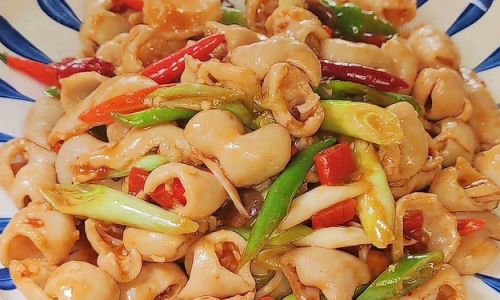
The Cleaning Process: A Critical Step
Proper cleaning is non-negotiable for eliminating off-putting odors and ensuring food safety. Follow these steps meticulously:
- Rinse Thoroughly: Place the intestines under cold running water, using your fingers to dislodge any visible debris.
- Scrub with Salt and Vinegar: Rub the intestines with coarse salt and white vinegar. This combination acts as a natural abrasive and deodorizer.
- Flip and Repeat: Carefully turn the intestines inside out (use a chopstick for assistance) and repeat the scrubbing process to remove residual fat and impurities.
- Soak in Flour Water: Submerge the intestines in a mixture of water and all-purpose flour for 30 minutes. The flour absorbs lingering odors and slime.
- Blanching: Boil the intestines in water with ginger slices and Shaoxing wine for 5–7 minutes. This step further purges impurities and tenderizes the meat.
Marination: The Foundation of Flavor
Marinating the intestines not only imparts flavor but also begins the process of tenderizing the meat. Create a marinade using:
- Cornstarch: Coats the intestines, creating a protective layer that ensures crispiness.
- Soy Sauce: Adds umami depth.
- Shaoxing Wine: Enhances aroma and neutralizes any remaining odor.
- White Pepper: Provides a subtle heat.
- Sesame Oil: Adds a nutty finish.
Marinate for at least 30 minutes, ensuring the intestines are evenly coated.
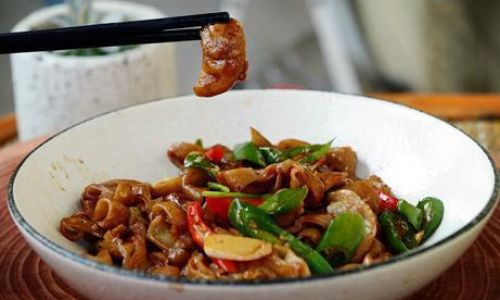
The Stir-Frying Technique: Heat and Speed
Stir-frying is a high-heat, rapid-cooking method that seals in flavors while achieving the desired crispiness. Follow these steps:
- Preheat the Wok: Heat a carbon-steel wok over high heat until it begins to smoke. A properly seasoned wok is essential for even heat distribution.
- Add Oil: Swirl in peanut or vegetable oil—oils with high smoke points are critical to prevent burning.
- Sear the Intestines: Add the marinated intestines in a single layer. Allow them to sear undisturbed for 1–2 minutes to develop a golden crust.
- Stir-Fry Vigorously: Toss the intestines continuously for 3–4 minutes. Avoid overcrowding the wok, as this lowers the temperature and steams the meat instead of frying it.
- Add Aromatics: Toss in minced garlic, ginger, and dried chili peppers during the last minute of cooking for aromatic complexity.
Achieving Crispiness: Key Factors
- Dry the Intestines Thoroughly: Pat them dry with paper towels before marinating to prevent sogginess.
- High Heat: Maintain a consistent high flame to evaporate moisture quickly.
- Short Cooking Time: Overcooking renders the intestines tough and chewy.
- Cornstarch Coating: Acts as a barrier, locking in juices while creating a crunchy exterior.
Seasoning and Flavor Balancing
The dish’s success hinges on balancing salty, sweet, spicy, and umami elements. Incorporate:
- Oyster Sauce: For savory richness.
- Sugar: A pinch to caramelize and balance bitterness.
- Dark Soy Sauce: For color and depth.
- Fresh Chilies: For vibrant heat.
- Cilantro or Scallions: For a fresh finish.
Adjust seasonings to taste, keeping in mind that the intestines will absorb flavors as they cook.
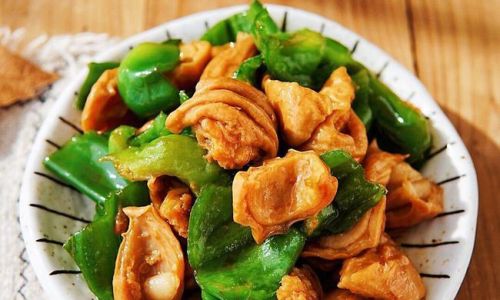
Troubleshooting Common Issues
- Soggy Texture: Likely caused by excess moisture. Ensure thorough drying and avoid overcrowding the wok.
- Bitter Aftertaste: Under-cleaning or overcooking. Double-check the cleaning process and reduce cooking time.
- Lack of Crispiness: Insufficient heat or cornstarch. Preheat the wok longer and ensure an even coating.
Variations and Pairings
Experiment with regional variations to suit your palate:
- Sichuan-Style: Add Sichuan peppercorns and doubanjiang (fermented bean paste) for a麻辣 (numbing-spicy) kick.
- Cantonese-Style: Pair with fermented black beans and bok choy for a lighter, aromatic profile.
- Taiwanese-Style: Incorporate basil and rice wine for a herbal twist.
Serve with steamed jasmine rice, pickled vegetables, or a cold beer to contrast the dish’s richness.
Advanced Techniques for Enthusiasts
- Double-Frying Method: Par-fry the intestines at 325°F (163°C) until blonded, then crank the heat to 375°F (190°C) for a final crisp.
- Baking Soda Tenderizing: Soak the intestines in a baking soda solution (1 tsp per cup of water) for 1 hour before rinsing thoroughly. This breaks down tough fibers.
- Velveting: Coat the intestines in a mixture of egg white, cornstarch, and oil for an ultra-smooth texture.
Cultural Significance and Etiquette
In Chinese cuisine, offal dishes like stir-fried intestines reflect a philosophy of “nose-to-tail eating,” honoring the animal by utilizing every part. The dish is often served during festivals or family gatherings, symbolizing prosperity and resourcefulness. When dining communally, use serving chopsticks to avoid cross-contamination, and pair with a mild broth to cleanse the palate between bites.
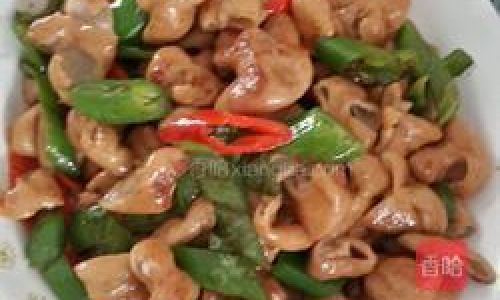
Conclusion: The Pursuit of Perfection
Mastering crispy stir-fried pork intestines is a testament to culinary dedication. It requires respect for tradition, attention to detail, and a willingness to embrace unconventional ingredients. By adhering to the techniques outlined here—from meticulous cleaning to precision stir-frying—you’ll unlock a dish that delights the senses and pays homage to centuries of gastronomic heritage. So, fire up your wok, gather your ingredients, and embark on a journey to create a dish that’s as crispy as it is culturally rich. Your taste buds—and dinner guests—will thank you.
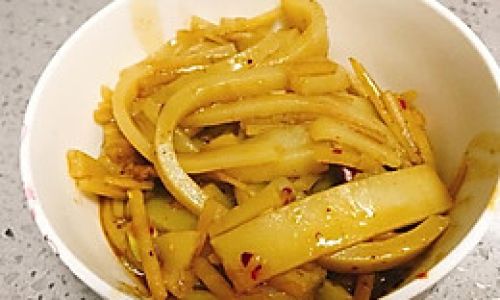
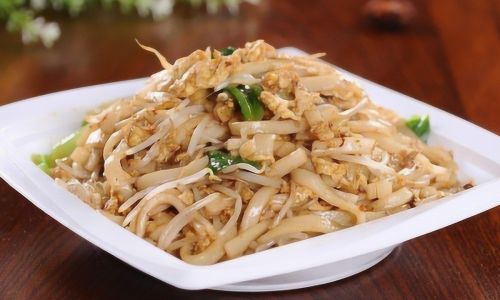



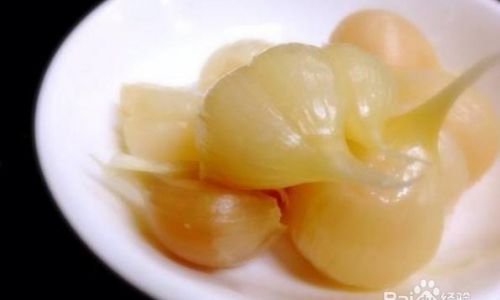
0 comments